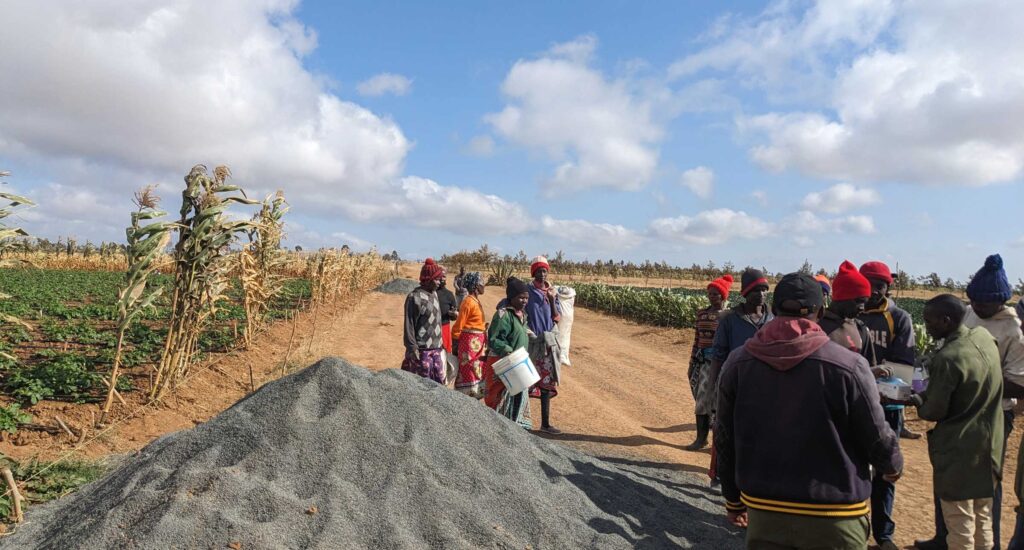Following PxD’s initiative identifying evidence-based climate change mitigation opportunities for smallholder farmers in the Global South, we are exploring ways to advance these opportunities in credible, inclusive, and equitable ways. This article is the second in a series detailing PxD’s market-shaping workstream on Enhanced Rock Weathering (ERW), which aims to identify pathways to catalyze a Global South-inclusive ERW industry benefiting people and the planet alike. We thank all the industry stakeholders who offered invaluable advice and feedback as we prepared this blog post. All views are our own.
- Commercial finance alone, e.g., through voluntary carbon markets, is insufficient to build the CDR industry with the necessary scale, speed, and consideration for distributional impacts.
- Instead, a mix of public and private finance designed with access/innovation, service delivery, risks, and distributional equity in mind can help launch the industry.
- An example of such a financing mechanism is an Advanced Market Commitment (AMC), a type of pull financing which aims to stimulate investment in products that may otherwise be ignored by the private sector.
- An AMC that blends resources from funders interested in achieving diverse goals, such as climate aims and poverty alleviation, can help incentivize distributionally equitable CDR investment.

The speed and scale at which a carbon dioxide removal (CDR) industry must develop to meet global needs – at least 1.5 GtCO₂eq annually by around mid-century- is unprecedented (CDR Primer, 2021). Only about 370,000 tons of CO₂ have been removed cumulatively since 2019. While this number is rapidly increasing, the technologies, scientific evidence, and financing mechanisms behind many carbon removal pathways are still evolving (cdr.fyi, accessed July 2024). Of these issues, the types of financing mechanisms used for CDR, how they are designed, and how they are managed are especially critical to the successful development of the industry. Financing structures will determine where CDR investments take place, what kinds of innovations are given priority, and which stakeholders’ voices and values are heard – all of which will influence the evolution of this industry for generations to come.
One CDR pathway with significant potential for carbon removal and livelihood co-benefits is enhanced rock weathering (ERW). Enhanced rock weathering leverages the natural weathering process of certain types of rocks to remove and store carbon dioxide permanently. When deployed on agricultural land, it can improve soil health and lead to crop productivity improvements. ERW carbon projects are primarily financed through the sale and purchase of carbon removals in voluntary carbon markets. Commercial finance alone, however, cannot provide key public goods that would characterize the success of an ERW market: the environmental benefits of carbon removals, the knowledge resulting from research and development (R&D), and economic equity.
Key Innovative Finance Considerations for ERW Market Catalyzation
Commercial demand for ERW is insufficient to deliver the scale of removals needed, and ton-denominated purchases through voluntary carbon markets incentivize the treatment of key public goods necessary to build the ERW mechanism as a private good for firms developing a specific approach, e.g. R&D for measurement, reporting, and verification (MRV) systems. Crucially, private sector-led investment can cause investment to primarily flow to high-income countries where there is existing infrastructure rather than Global South geographies where ERW has the most CDR potential, has the potential to be more cost-effective, and provides significant co-benefits for poverty alleviation and food systems sustainability (PxD, 2023)
So, the question is how to structure a financial instrument that balances access/innovation, service delivery, risks, and distributional equity to realize ERW’s true potential. Three key considerations must be considered when designing such an instrument.
1. Access and Innovation – Address information asymmetries and uncouple consumer costs from the rewards of research and development.
Markets are typically poor catalyzers for public goods. In the case of ERW technology development, there are several public good aspects to R&D. Most notably, the MRV of carbon removal outcomes helps define the specifications of an ERW carbon removal product (PxD, 2023). Offsetting market approaches incentivize firms to keep their R&D insights proprietary as there is no reward mechanism for the public good elements of sharing such insights, e.g. building the scientific evidence base to move towards more scalable and cost-effective model-based MRV. Such field building is critical in ERW technology development to define the ERW product and its carbon removal potential, develop measurement approaches, and understand its agronomic effects across various geographies. Current financing through voluntary carbon markets incentivizes firms to answer these questions individually as they compete on the “integrity” of their CDR product. To fund this R&D, firms pass on their costs to consumers, elevating carbon removal prices and limiting available demand. This limits the potential size of the ERW market. To build both the supply and demand of ERW, the rewards of field-building R&D should be uncoupled from consumer – or buyer-price. R&D to address public good evidence gaps should be rewarded, but in a way that incentivizes distributive efficiency and does not constrain consumer demand for the end product.
2. Service Delivery – Facilitate the valuation of longer-term benefits and create efficient frameworks for accountability.
Governments generally cannot commit to doing things in the future, e.g. future procurement, given the nature of government budgeting processes. It is thus difficult for governments to invest in longer-term benefits, such as purchasing carbon removal for delivery later. In the case of ERW, however, the chemical processes through which carbon removal occurs require time. This is especially true considering the time scale for when carbon removed from ERW is deemed permanently stored, as carbonates in either aqueous or solid forms. It is thus difficult for governments to supply the kind of stable demand ERW firms require for continued operations.
In addition, when it comes to technological development, government bureaucrats are seldom best placed to determine when and if a technology is successful. Governments lack the expertise for such assessments, and when placed in such a role, they tend to have slow exits from unsuccessful projects. There can also be political ramifications for spending taxpayer funds on “failed” initiatives. Government-led R&D efforts can thus lead to continued investment in poor-performing projects. Market actors, however, are better placed to have the right expertise in place, more efficient feedback loops, and swifter exits in response to market signals.
3. Risk Management – Allocate risks to the party best able to manage that risk.
In designing a financing mechanism that can address market and government shortcomings, it is critical to allocate risks efficiently. For example, if their product creates the intended outcome, i.e. carbon removal, producers should have some certainty there will be demand for the product. Likewise, buyers should be protected from the risk that the technology does not work. While there is no way to remove these risks from transactions, they can be allocated to the party best able to manage that type of risk by diversifying and reducing uncertainty. For example, pre-commitment of CDR purchases at a specific price, but not a specific volume, protects producers from some demand-side risks while protecting consumers from the supply-side risk that a technology may not work.
A “Diverse” Market Commitment to Accelerate the Global ERW Market
An outcomes-based financing instrument, like an advanced market commitment or development impact bond, could address some barriers to scaling up the global ERW market. These types of finance mechanisms signal buyer demand while only committing financing if outcomes are achieved.
For example, an evolution of the advanced market commitment (AMC) approach could support ERW activity globally, particularly in the Global South. Traditionally, AMCs target a single outcome and are funded by similar outcome funders interested in the same outcome. In the case of ERW, where we value the livelihood benefits of ERW activity in the Global South and its CDR potential, incentivizing both livelihood and CDR outcomes by blending different types of outcomes funders together could grow the market more equitably.
At a very high level, such a “diverse” market commitment could blend poverty alleviation and climate funders to offer an AMC that provides a premium for carbon removal through ERW deployed in Global South geographies. The need for this premium would eventually disappear as the initial R&D investment required goes down due to technological improvements. Decreasing costs would help open the door to other types of buyers, particularly governments, which are cost-sensitive but could procure at the scale needed. Critical to this effort would be the requirement for firms to publicly share data critical for evidence generation across the field and create a platform/structure to manage this data sharing.
More specifically, how such an AMC could be operationalized is:
- Corporates and other actors interested in buying permanent carbon removal join the AMC and commit to buying credits at a low marginal cost. They determine the volume purchased. This opens the door for permanent CDR procurement to a broader group of buyers than those who’ve traditionally invested in pioneering CDR pathways like ERW.
- A blend of outcome funders, both carbon removal and those interested in poverty alleviation, commit to topping up the marginal cost of credits by a certain premium per ton. Given demonstrated benefit-sharing (e.g., via carbon payments) with local communities, there is an additional premium per ton for carbon removal through ERW in Global South geographies.
- Corporates and funders do not commit to paying in advance—funds will be transferred only once the outcome has been achieved. However, the key is that corporates and funders commit to buying if the outcome is achieved according to a previously agreed-upon standard.
- The AMC has a finite amount of money to provide premiums, which motivates speed as the money will eventually run out.
- To participate in the AMC, firms must commit to sharing a specific subset of data that was previously agreed upon and determined as critical to developing ERW understanding more broadly.
- Firms should leverage traditional forms of market finance, like debt or equity financing, to finance upfront costs. These forms of market finance are purpose-built to manage a portfolio of risks with efficient exit mechanisms. It is up to firms to convince these market finance entities that their approach will provide the outcomes needed to obtain the AMC’s premiums.
In this version of an AMC, the funder doesn’t pick the “winner” as investors are still taking the risk. Indeed, this may help surface strategies that are too risky for the nascent CDR market. Funders also are not committing funds to anything that doesn’t achieve their intended outcome. Firms, however, still receive a strong demand signal. They know if they produce the outcome, given a predetermined standard, the AMC will buy their credits. And as buyers still determine the volume of procurement, firms must ensure the final product works for their particular customer. This also incentivizes diversification as some buyers may prefer ERW projects with certain profiles, e.g. in a specific agricultural value chain, as the buyer works primarily in that value chain.
Many important details are still required to flush out such an AMC. For example, what exactly should the marginal cost and premiums provided be? How does one determine the evidentiary standard? What kinds of data are critical to share to build the field, and which are not? However, the general premise for an AMC, which pays for both carbon removal and livelihood outcomes, should provide the market with the incentives needed to catalyze ERW more globally.
PxD welcomes feedback on the ideas we present in this article and future ones and appreciates different perspectives on this issue. If you would like to get in touch, please contact info@precisiondev.org.


Stay Updated with Our Newsletter

Make an Impact Today




